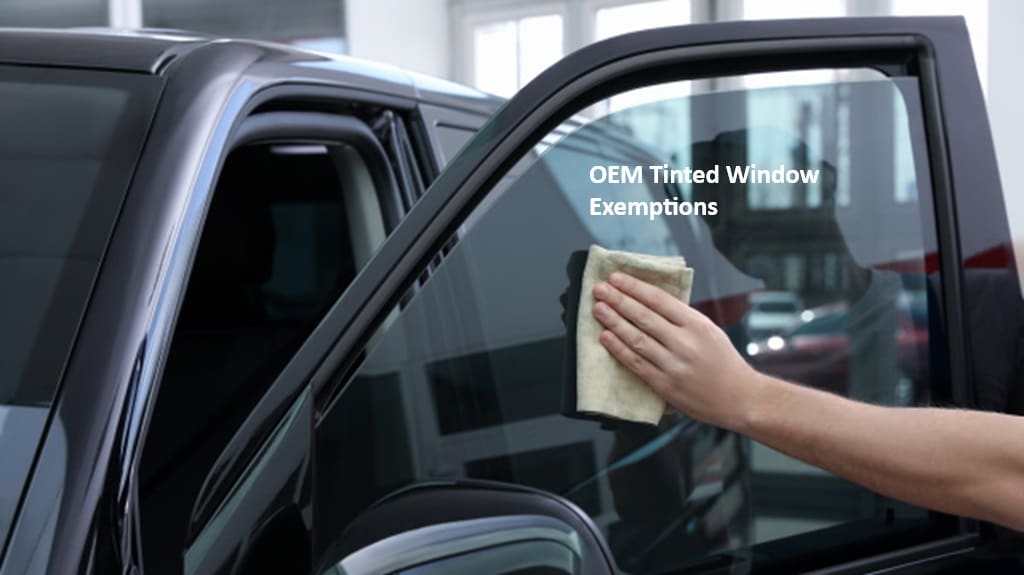If you are a car driver, whether a Sedan or SUV, you must know the tinting laws according to your state. However, OEM tinting is sometimes insufficient to protect you from UV rays and direct sunlight. So, there’s always a need for marketed window tints.
These marketed window tints have enough VLT to protect you from harmful rays and sunlight. Moreover, you must know OEM tinted windows exemptions before installing these films. This article will explain these laws, exemptions, and manufactured tints. Please keep reading to learn more about it.
OEM Tinted Window Exemptions
Are you worried about OEM tinted window exemption? Or got some window tint regulations to deal with? You’re not alone. Decoding OEM tinted windows can help you stay legal and safe on the road. OEM or Original Equipment Manufacturer tint is what you get straight from the factory.
Car manufacturers usually do this to car’s windows during the manufacturing process. However, your vehicle gets all necessary treatments like tinting, paint, and seat covers during production that maintains the vehicle maker sets specific standards.
What’s the Deal with OEM Tinted Windows?
Car manufacturers slap factory tints on the back windows for privacy and comfort. But heads up, it doesn’t do much against UV rays and heat compared to aftermarket films. Furthermore, OEM gives you some advantages, but aftermarket options open up a mixture of shades, colors, and tech (Madico). You can choose it according to your wishes and inspirations. Moreover, according to your state’s laws, your window tints will protect you from UV rays and tickets and penalties.
Why Bother with OEM Tinted Windows?
- UV Protection: Aftermarket tints usually block 99% of those harmful UV rays—way better than your factory tint. This keeps you and your car’s interior from turning into leather jerky. Plus, your passengers will thank you (Madico).
- Beating the Heat: Aftermarket films are champs at reflecting and soaking up the sun’s heat, especially infrared light. This keeps your car cool and reduces A/C use, saving some bucks at the pump—something your OEM tint doesn’t do.
- Safety First: Ever had a window shatter on you? I’m not joking, but the truth is that OEM tint won’t help much there. Aftermarket films, though, come with an adhesive that holds broken glass together. It makes accidents and break-ins a lot less messy.
Knowing the pros and cons of OEM tinted windows can make a huge difference for any driver. Ensure you’re in the loop on local laws, weigh your options, and pick what’s best for you.
Ohio Window Tint Laws: What You Need to Know
If you’re thinking about getting your car windows tinted in Ohio, there’s some stuff you need to know first. It might seem minor, but Ohio’s rules on how dark and shiny your window tint can be are pretty specific. Whether you drive a sedan, SUV, or van, you’ve got to stay on top of these rules to avoid any sticky situations.
How Dark and Reflective Can Your Tint Be?
In 2004, Ohio laid down the law about how dark and reflective your window tint can be. They use Visible Light Transmission (VLT) to determine how much light gets through the tint. The lower the percentage, the less light gets through. Stick to these percentages to keep yourself out of trouble and make sure everyone’s safe on the road.
For sedans, SUVs, and vans, they’ve got different rules. It’s all about keeping things clear, safe, and visible while letting you enjoy the perks of tinted windows.
The Rules: Sedans vs. SUVs/Vans
So, you’re driving a sedan? Ohio’s got specific numbers on how dark your windows can be. The same goes for SUVs and vans but with their own set. It’s all designed to handle the unique quirks of each type of vehicle so everyone can stay safe.
Ignore these rules, and you might find yourself in trouble—fines, penalties, or worse. Keep it legal by knowing what counts for your specific ride.
Other Stuff You Should Know
There’s more to Ohio’s window tinting laws than just how dark it can be. Some local rules might be stricter depending on where you live. Always double-check to avoid those nasty surprises.
In summary, follow the laws to keep your car looking fabulous and your record clean. If you stay informed, you’ll avoid the hassle of fines and keep yourself and others safe on the road.


